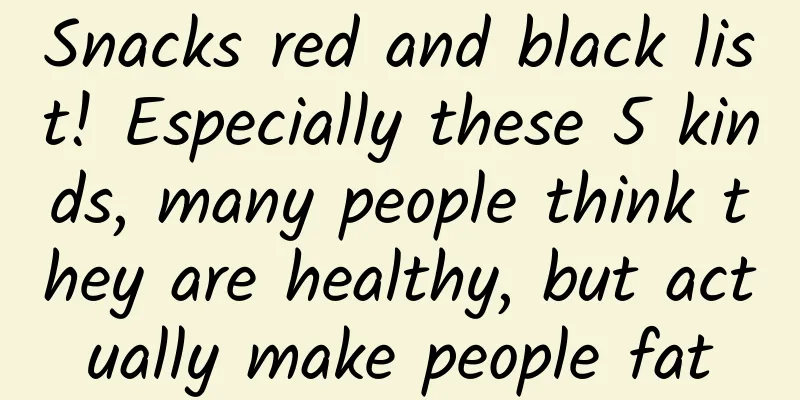Snacks red and black list! Especially these 5 kinds, many people think they are healthy, but actually make people fat

|
During the Spring Festival, many families will prepare some snacks to entertain relatives and friends. However, many people think that snacks are high in oil, sugar and salt, which are bad for the body, so they dare not eat them. Festivals without snacks are bound to be less fun. So, what kind of snacks are relatively healthier? What are some healthy snacks ? Let's talk about them in detail today. Copyright images in the gallery. Reprinting and using them may lead to copyright disputes. Don’t be fooled by “low-calorie snacks” Low-calorie snacks that have "emerged" on the market are the target of consumption for many young people. The primary requirement of most consumers when choosing healthy food is that it is "delicious and does not make you fat", and the leading slogan for healthy snacks is "low-calorie", which aims to achieve the goal of weight loss by controlling calories. Most healthy snacks reduce the calories in foods by replacing raw materials and optimizing processes: for example, replacing traditional pork and beef with plant protein meat in jerky; replacing deep-frying and puffing in potato chips with low-temperature dehydration; replacing the usual noodles with konjac noodles or flour in hot and sour rice noodles; or replacing traditional sucrose with sugar substitutes in beverages and cakes. However, please note that "low calorie" does not mean "healthy" . The content of sugar, sodium, fat, protein, etc. should also be used as indicators to measure whether snacks are healthy . Therefore, when choosing snacks, you should master the "two choices". 1 Choose foods low in sodium, sugar, and fat The reason why food in restaurants outside is more tempting is mainly due to its "heavy taste", and this "heavy taste" is determined by condiments such as salt, refined sugar, and lipids. However, eating too much sodium will inevitably increase the metabolic burden on the kidneys, affect their normal function, and even cause damage; excessive intake of refined sugar will cause the body to be attacked by problems such as tooth decay, obesity, and diabetes; and excessive intake of fat will increase the body's risk of cardiovascular and cerebrovascular diseases such as obesity and dyslipidemia. Therefore, when purchasing snacks, you need to pay attention to the "Nutrition Information" on the food label and buy "light-tasting" snacks that are low in sodium, sugar, and fat . Take the following list of ingredients for braised chicken feet as an example. According to the Chinese Dietary Guidelines, the daily salt intake for adults is recommended to be within 5 grams, which is equivalent to about 1967 mg of sodium intake. However, the sodium content of this braised chicken feet is 737 mg per piece, so eating 3 pieces is excessive. Image source: Product screenshot 2 Choose fresh, wholesome, minimally processed foods Relatively speaking, fresh and hygienic food has higher nutritional value, purer taste and higher safety factor. Food with less processing degree contains less salt, refined sugar, trans fatty acids, etc., and can better ensure health. The best one is the one that suits you If you want to eat snacks healthily, another key part is to choose snacks that are suitable for you. You can compare your current meals with the Dietary Guidelines for Chinese Residents, and then choose snacks to supplement the remaining parts. For example, many people do not get enough dietary fiber during meals, so they can choose fresh fruits and vegetables as snacks; if they lack high-quality protein during meals, they can drink some milk or yogurt and eat a boiled egg in their free time. People with special physical conditions should choose snacks with caution. Copyright images in the gallery. Reprinting and using them may lead to copyright disputes. For example, patients with hypertension should avoid eating high-salt foods, people with tooth decay should avoid eating high-sugar foods, and obese people should limit high-calorie snacks. Different situations need to be treated differently. After we choose the right snacks, can we eat as much as we want without any burden? Don’t think like that! The value of snacks lies in their “additional attributes beyond regular meals”. Snacking should be done in moderation. Just a few snacks cannot meet the body’s multiple needs for nutrients. It is recommended to control the proportion of calories consumed from snacks to 10%~20% per day. It is best to eat them between meals (when you are almost hungry). You can choose a handful of unseasoned nuts, a cup of yogurt (preferably sugar-free and fat-free) and a medium-sized apple. However, it should be noted that modern people (especially those living in urban environments) often have excessive calorie intake. Eating extra snacks can easily lead to obesity and increase the risk of chronic diseases. If the calorie intake of regular meals on a certain day is sufficient, try not to eat snacks. Children and adolescents eating snacks Pay more attention Children and teenagers are the groups that love snacks the most, but this group is also the one that should pay the most attention to the types of snacks. In 2018, my country released the "Guidelines on Snacks for Chinese Children and Adolescents (2018)", jointly compiled by the Institute of Nutrition and Health of the Chinese Center for Disease Control and Prevention and the Chinese Nutrition Society, which provided snack consumption guidance for children and adolescents (2 to 17 years old). Copyright images in the gallery. Reprinting and using them may lead to copyright disputes. The guidelines recommend that the total energy provided by snacks for children and adolescents should not exceed 10% of their total energy intake in a day. It is recommended to choose foods that are not consumed in regular meals as snacks, such as milk and dairy products, fruits, and nuts. Snacks should be eaten less frequently and in smaller amounts each day. It is best to eat snacks 1.5 to 2 hours apart from regular meals. At the same time, the guidelines also provide guidance on snack intake for children and adolescents of different age groups, and also have their own snack intake recommendations for children and adolescents of different age groups: Children aged 2 to 5 should eat regular meals, snacks and snacks in moderation. They should also stay quiet when eating snacks to prevent choking. School-age children aged 6 to 12 should also focus on regular meals, pay extra attention to the proper combination and intake of breakfast, and eat snacks in small amounts; Teenagers aged 13 to 17 should eat three meals a day, and pay special attention to avoid replacing meals with snacks. Meanwhile, there are five common guidelines for children and adolescents: 1. Fruits, milk and nuts are the preferred snacks . The dietary guidelines recommend that healthy people over 2 years old consume 200-350 grams of fruit, 300 grams of milk and about 10 grams of nuts per day. It is necessary to remind everyone that fruit juice (whether it is freshly squeezed juice purchased or homemade fruit juice) cannot replace fruit; milk-containing beverages are not equivalent to liquid milk; for children who experience abdominal pain, diarrhea, bowel sounds and other lactose intolerance symptoms after drinking milk, yogurt or low-lactose dairy products can be preferred, and can also be consumed in small amounts and multiple times, and eaten with other cereal foods, and do not drink milk on an empty stomach. 2. Eat less high-salt, high-sugar, high-fat, smoked and fried snacks . According to the General Rules for Nutrition Labeling of Prepackaged Foods (GB28050-2011), foods with a sodium content of ≤120 mg/100 g (solid) or 100 ml (liquid) are low-sodium foods; foods with a sugar content of ≤5 g/100 g (solid) or 100 ml (liquid) are low-sugar foods; foods with a fat content of ≤3 g/100 g (solid) or ≤1.5 g/100 ml (liquid) are low-fat foods. 3. Do not drink or drink less sugary drinks, and do not drink alcohol. 4. Snacks (such as fruits) should be fresh, nutritious and hygienic . 5. Keep your mouth clean and do not eat snacks before going to bed . From the perspective of health and nutrition, the above five guidelines are also applicable to adults who love snacking. Nowadays, there are all kinds of snacks on the market, many of which are high in sugar, fat, and salt. Although these snacks can satisfy everyone's taste needs in terms of seasoning, they have a significant impact on the health of children and adolescents. As adults, we can satisfy our appetite occasionally, but long-term consumption of these "three high" foods can also pose a threat to the cardiovascular and cerebrovascular systems. "Five to Five" Snack Red and Black List Having said so much, I would like to recommend five healthy snacks based on the guidelines. In addition, there are five snacks that we usually think are healthy but are actually not healthy. 1 Red List Snacks Snack No. 1 on the Red List: Yogurt Recommended reason: Yogurt is not only nutritious, but also easy to digest and absorb, and promotes the balance of intestinal flora. It is especially suitable for people with lactose intolerance. Drinking some milk or yogurt every day can provide rich protein and calcium. Drinking yogurt regularly can promote intestinal movement, soften and ferment the contents of the colon, increase fecal excretion, and prevent constipation. Rich in nutrients: Streptococcus thermophilus, Lactobacillus bulgaricus, Lactobacillus casei, Lactobacillus rhamnosus. Snack No. 2 on the Red List: Pure Milk Recommended reason: Drinking more milk can prevent children from obesity and chronic diseases such as hypertension and diabetes in adulthood. There are also skimmed, semi-skimmed and whole milk to choose from. Rich in nutrients: mineral calcium, high-quality protein. Snacks No. 3 on the Red List: Original Nuts Recommended reason: It has a strong sense of fullness, can prevent cerebrovascular disease, ensure blood flow, and help you keep your brain healthy and excited. Rich in nutrients: essential fatty acids such as linoleic acid and linolenic acid, rich in vitamin B, vitamin E, and minerals and trace elements such as calcium, phosphorus, iron, especially zinc. Snack No. 4: Whole-wheat biscuits Recommended reason: strong sense of satiety and rich wheat aroma. Rich in nutrients: dietary fiber, oryzanol, lignans. Snack No. 5: Cheese Recommended reason: It is beneficial to intestinal health and improves immunity. Rich in nutrients: calcium, protein, active lactic acid bacteria. 2 Blacklist snacks Snacks on the Black List No. 1: Seasoned Nuts Reason for not recommending: Seasoned nuts have added sugar, salt and other flavoring agents. Seasoned nuts can mask the spoilage of nuts. Snacks on the blacklist No. 2: Dairy drinks Reason for not recommending: Milk drinks with added sugar ingredients such as white sugar, sucrose, fructose, etc. increase calories and the risk of obesity. Blacklist snacks No. 3: Fruit and vegetable chips, sweet potato chips, etc. Reason for not recommending: Fruit and vegetable chips that have been vacuum fried and dehydrated will result in extra fat intake and the addition of extra sugar and salt as long as they are fried. Copyright images in the gallery. Reprinting and using them may lead to copyright disputes. Blacklist snack No. 4: meat jerky and egg snacks Reasons for not recommending: Most of these snacks are smoked or marinated, and contain large amounts of oil, salt, sugar, soy sauce, MSG and other condiments. During the production process, the food loses a lot of nutrients. A small amount of sodium nitrite is also added as a preservative and color enhancer. Long-term use is harmful to the body. Blacklist snack No. 5: Juice Reasons for not recommending: Fruit juicing destroys the plant cell walls, increasing the free sugar in the fruit juice and thus increasing the blood sugar response. Therefore, eating the whole fruit is more beneficial than drinking juice. What healthy snacks do you like to eat? Feel free to leave a message in the comment area to tell everyone! You are also welcome to leave some unhealthy snack types to help other friends avoid them! Planning and production Author: Xu Lang, popular science creator Review | Ruan Guangfeng, Deputy Director of Kexin Food and Health Information Exchange Center Editor: Zhong Yanping Proofread by Xu Lailinlin The pictures and cover picture of this article are from the copyright gallery. Reprinting and using them may cause copyright disputes. |
<<: Remind your family and friends! Don’t use this posture to browse your phone
>>: Ancient discovery: Adding legs to a snake?! Why did snakes lose their limbs?
Recommend
User operations, how to solve user pain points?
When considering user needs, we look at the produ...
Meizu Note 3 review for 799 yuan: Is it an illusion that it is almost the same as iPhone?
When Lei Jun first started learning how to give s...
Can eating bananas relieve constipation? Not true! Such bananas will aggravate the symptoms
gossip In our daily lives, we are often advised a...
Don’t know how to plan advertising? Here is a complete set of templates!
Information flow advertising is now the new favor...
Can't stop coughing? Can't get better after having a cold for half a month? Go to the hospital immediately!
Recently, influenza A, influenza B, syncytial vir...
The community is so popular, but are you sure you really need it?
The Internet has never been short of concepts. Fo...
iOS 10 will usher in HomeKit independent application. Will Apple still be the smart home disruptor?
In 2014, Google acquired Nest Labs for $3.2 billi...
A man died after extracting 23 teeth at once! Can you only extract one tooth at a time?
When it comes to tooth extraction, everyone is fa...
How much does it cost to rent a server with 8 cores and 16G per year?
Server rental is divided into two categories: ind...
Platform-based brand marketing strategy!
There are huge differences in brand marketing bet...
Apple releases iOS 12 GM version: officially pushed on September 18
At Apple's Gather Round conference early this...
World Sleep Day丨Take a look at the self-help guide for staying up late and suffering from insomnia!
Today (March 21) is World Sleep Day. Perhaps you ...
HR Practical Analysis Member Baidu Cloud Download
Human Resources Practical Analysis Member Resourc...
Does the mini program mall have strict requirements on products? What issues should be paid attention to when developing a mini program mall?
Does the mini program mall have strict requiremen...









